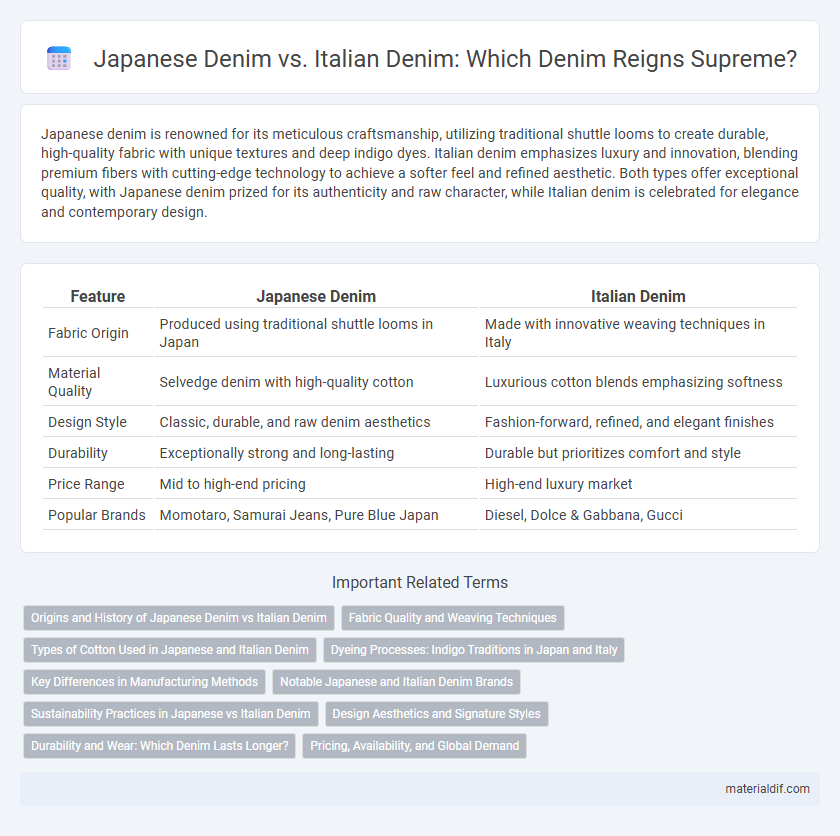Japanese denim is renowned for its meticulous craftsmanship, utilizing traditional shuttle looms to create durable, high-quality fabric with unique textures and deep indigo dyes. Italian denim emphasizes luxury and innovation, blending premium fibers with cutting-edge technology to achieve a softer feel and refined aesthetic. Both types offer exceptional quality, with Japanese denim prized for its authenticity and raw character, while Italian denim is celebrated for elegance and contemporary design.
Table of Comparison
| Feature | Japanese Denim | Italian Denim |
|---|---|---|
| Fabric Origin | Produced using traditional shuttle looms in Japan | Made with innovative weaving techniques in Italy |
| Material Quality | Selvedge denim with high-quality cotton | Luxurious cotton blends emphasizing softness |
| Design Style | Classic, durable, and raw denim aesthetics | Fashion-forward, refined, and elegant finishes |
| Durability | Exceptionally strong and long-lasting | Durable but prioritizes comfort and style |
| Price Range | Mid to high-end pricing | High-end luxury market |
| Popular Brands | Momotaro, Samurai Jeans, Pure Blue Japan | Diesel, Dolce & Gabbana, Gucci |
Origins and History of Japanese Denim vs Italian Denim
Japanese denim originated in the early 20th century, influenced by American denim introduced to Japan, with Kojima, Okayama becoming its historic production hub known for selvedge denim and traditional shuttle looms. Italian denim, rooted in Italy's rich textile heritage dating back to the Renaissance, combines artisanal craftsmanship with modern innovation, famously produced in regions like Prato and Conegliano, emphasizing luxury and high fashion. Both traditions highlight distinctive cultural values, with Japanese denim focusing on durability and authenticity, while Italian denim embodies elegance and premium quality.
Fabric Quality and Weaving Techniques
Japanese denim is renowned for its exceptional fabric quality, often crafted from high-purity, long-staple cotton that ensures durability and a smooth texture. The weaving techniques in Japanese denim, such as the traditional shuttle loom method, create a dense, tightly woven fabric with a distinct selvedge edge prized for its resistance to fraying. Italian denim, conversely, emphasizes luxurious texture and finish through advanced weaving technologies and premium cotton blends, combining tradition with innovation to produce soft, lightweight fabrics that maintain strength and comfort.
Types of Cotton Used in Japanese and Italian Denim
Japanese denim is renowned for using high-quality, long-staple cotton varieties such as Zimbabwe and American Pima cotton, which provide exceptional strength, softness, and durability. Italian denim often features a blend of extra-long staple Egyptian cotton and Turkish cotton, creating a luxurious feel with a slightly heavier weight and refined texture. Both regions emphasize premium cotton fibers but achieve distinct fabric characteristics through their unique sourcing and spinning techniques.
Dyeing Processes: Indigo Traditions in Japan and Italy
Japanese denim is renowned for its intricate indigo dyeing process, which uses natural, slow-fermenting indigo vats that produce deep, rich hues and superior colorfastness. Italian denim employs advanced synthetic indigo dyes combined with cutting-edge machinery, ensuring uniformity and vibrant tones that cater to high-fashion demands. The craftsmanship in Japan emphasizes heritage techniques that enhance fabric texture, while Italy's focus is on precision and innovation for luxury denim finishes.
Key Differences in Manufacturing Methods
Japanese denim is renowned for its traditional shuttle loom weaving technique, producing a denser, more durable fabric with a distinctive selvage edge, while Italian denim often utilizes modern projectile looms, allowing for softer textures and a wider variety of finishes. The meticulous hand-dyeing process of Japanese denim using natural indigo contrasts with Italian denim's diverse dyeing methods, which include both synthetic and natural dyes to achieve a broader color spectrum. Japanese denim emphasizes slow, handcrafted production focused on quality and longevity, whereas Italian denim prioritizes innovation, design flair, and comfort through advanced manufacturing technology.
Notable Japanese and Italian Denim Brands
Japanese denim is renowned for brands like Samurai, Momotaro, and Pure Blue Japan, celebrated for their meticulous craftsmanship and high-quality selvedge denim produced on vintage shuttle looms. Italian denim brands such as Diesel, Replay, and Dondup are recognized for their innovative designs, premium fabrics, and a blend of traditional techniques with contemporary fashion trends. Both countries emphasize durability and style, with Japanese denim focusing more on heritage and artisanal production, while Italian denim highlights luxury and trend-forward aesthetics.
Sustainability Practices in Japanese vs Italian Denim
Japanese denim emphasizes sustainable practices through traditional shuttle looms that reduce fabric waste and long-lasting dyeing techniques using natural indigo, supporting environmental preservation. Italian denim integrates eco-friendly innovations such as waterless dyeing processes and organic cotton sourcing, combined with stringent regulations ensuring reduced carbon emissions and chemical use. Both regions prioritize sustainability but diverge in methods, with Japan focusing on craftsmanship and natural materials while Italy leverages industrial technological advancements for eco-conscious production.
Design Aesthetics and Signature Styles
Japanese denim is renowned for its meticulous craftsmanship and vintage-inspired indigo hues, emphasizing raw, selvedge edges that highlight traditional shuttle loom weaving techniques. Italian denim, contrastingly, blends luxury fashion sensibilities with innovative fabric treatments, featuring sleek silhouettes and bold washes that reflect contemporary elegance. Both styles deliver distinct aesthetics: Japanese denim offers heritage authenticity and durability, while Italian denim prioritizes refined texture and high-fashion appeal.
Durability and Wear: Which Denim Lasts Longer?
Japanese denim is renowned for its exceptional durability due to traditional shuttle loom weaving and high-quality cotton, resulting in thicker, more wear-resistant fabric. Italian denim, while known for luxurious finishes and fashionable aesthetics, typically prioritizes style over long-term wear, often using lighter weight materials that may fade or wear quicker. The meticulous craftsmanship and indigo dyeing techniques used in Japanese denim contribute to superior longevity compared to the often trend-driven Italian denim.
Pricing, Availability, and Global Demand
Japanese denim commands premium pricing due to meticulous craftsmanship and limited batch production, appealing to niche luxury markets. Italian denim offers broader availability and competitive pricing, benefiting from well-established textile manufacturing and global distribution networks. Global demand for Japanese denim is driven by exclusivity and superior quality, while Italian denim attracts mass-market consumers seeking balance between style and affordability.
Japanese Denim vs Italian Denim Infographic

 materialdif.com
materialdif.com